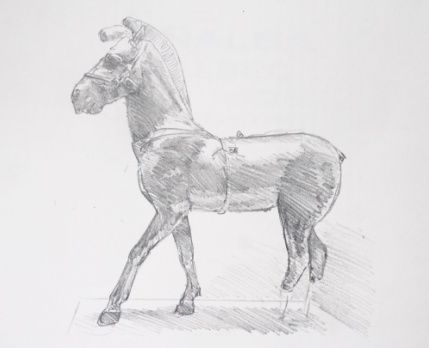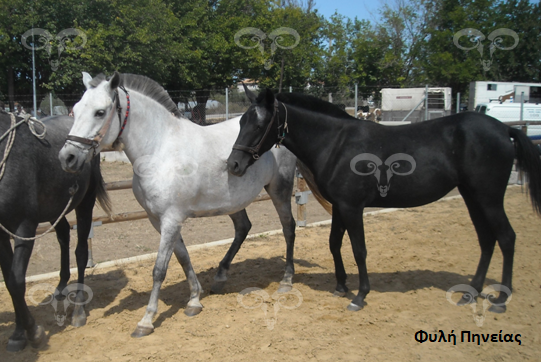History
The Penia breed evolved in the semi-mountainous regions of the Elia prefecture in Peloponnese. The lack of historical references leads to the conclusion that the breed developed during the Ottoman period when native horses were crossed with Arab-type horses brought to Greece by the Ottomans.
However, there are noteworthy indications that pace horses already existed in antiquity. Statues and other artifacts dating back to the 5th century BC depict horses in a pacing position, αs evidenced by the small bronze statue of a horse with the characteristic gait of a pacer dated at 470 BC, (Sketch 2) displayed at the Archaeological Museum of Olympia.


It is also worth mentioning that the morphological traits of the horse in this statue are similar to those of the present-day Penia horse and that the statue was found in Olympia, the same region where the Penia breed originated.
Morphological Traits
The height of the present-day Penia horse is 125 -145 cm at the withers. The head is square with a masculine expression, the chest is deep, the neck is especially muscular, and the legs slender. The mane and tail are abundant. Finally, there is strong sexual dimorphism, with the females showing less intense morphological traits.
The common colours are black, bay and grey. The hooves are hard and dark. White markings on the forehead or legs are absent. The Penia horse is a healthy, low maintenance horse with great stamina and a nervous temperament.
Use
The qualities of the Penia horse render this breed especially popular. The impressive posture, great stamina for its size and spirited nature together with the pacing gait which is very relaxing for the rider, make this breed suitable for a variety of agricultural tasks. It is mainly used by livestock breeders and farmers as a pack animal in hard to reach areas, but it is also used for leisure riding.
Population
As there is no breeders association, cases of crossbreeding and inbreeding occur, altering the true character of the breed. According to data from the Center of Animal Genetic Resources (2019), there are 42 females and 29 males registered.
However, the actual population size is much larger, estimated at approximately 500 horses. The population of the breed is classified as
‘Endangered’.




